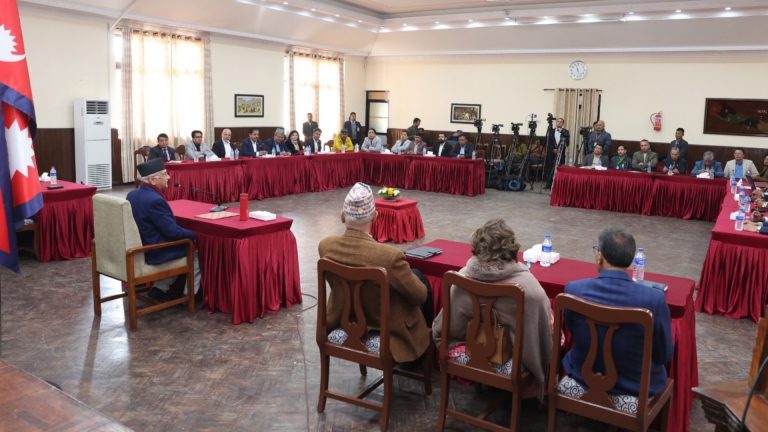Nepal’s exports reached an astronomical figure last fiscal year—NRs 277.03 billion, also marking one of the largest annual growths in the country’s dismal trade history.
In the decade of the 2010s, Nepal’s exports were mostly about setbacks. Even in the 2000s, the country largely struggled to boost its exports. The hundred billion rupees mark seemed unattainable while its trade deficits ballooned [last fiscal year, it stood at NRs 1.527 trillion].
A turning point came in 2020/21 when exports surprisingly rose by 44% registering a record level—141.1 billion rupees. And the recent surge, almost 235% the exports in 2020/21, with the latest exports recording a staggering growth of 81% sounds great news.
Chart 1: Export Trend Over the Last 10 Years
Graph 2: Leading 20 exports in 2024/25
Although this growth appears like a success story, there are nuances.
A large portion of the country’s present exports is due to the re-export of edible oils—soybean, sunflower, and safflower. Last fiscal year, the country exported 509.96 million kg of refined soybean oil and 53.24 million kg of sunflower and safflower oil, amounting to NRs 106.79 billion and NRs 12.33 billion, respectively. They formed 43% of the total exports. Nearly all of it was re-exports to India. Compared to previous fiscal year data, their growth in exports is over around 17,450%.
Notably, Nepal is a marginal producer of these oilseeds, and primarily imports crude edible oil from distant markets such as Argentina, Brazil, Ukraine; refines them, and re-exports to India.
This practice leverages Nepal’s membership privilege in the regional South Asia Free Trade Agreement (SAFTA)—while India levies a high tariff on refined oil imported from third countries, it offers concessions to Nepal under SAFTA, which has created an arbitrage opportunity for traders and a windfall for the country. There’s a common view however that the value addition has remained minimal in Nepal although the SAFTA requires 30% value addition for the zero-tariff privilege.
Table 1: Import statistics of edible oil (crude) in FY 2024/25
| Commodity | Country | Quantity(in million kg) | Imported Value (in Rs. billion) | Composition |
| Crude soya-bean oil | Argentina | 585 | 88.91 | 81.60 |
| Brazil | 66 | 10.00 | 9.18 | |
| Ukraine | 20 | 3.24 | 2.98 | |
| Thailand | 17 | 2.34 | 2.14 | |
| Iraq | 13 | 1.93 | 1.77 | |
| Paraguay | 7 | 0.99 | 0.90 | |
| China | 6 | 1.02 | 0.93 | |
| Benin | 3 | 0.39 | 0.36 | |
| Togo | 1 | 0.14 | 0.13 | |
| Total | 718 | 108.95 | ||
| Crude Sunflower oil | Ukraine | 136 | 20.07 | 224.30 |
| Argentina | 57 | 8.89 | 99.39 | |
| Romania | 0.26 | 0.05 | 0.54 | |
| India | 0.04 | 0.01 | 0.07 | |
| Total | 58 | 8.95 | ||
Table 2: Export statistics of edible oil (excl. crude) in FY 2024/25
| Commodity | Country | Quantity(in million) | Imported Value(in Rs. billion) | Composition |
| Soya-bean oil (excl. crude)(In kg) | India | 510 | 106.79 | 99.9996 |
| Australia | 0.00042 | 0.000419 | 0.0004 | |
| Total | 510 | 106.79 | ||
| Sunflower-seed and safflower oil (excl. crude)(in Ltr) | India | 53 | 12.33 | 100 |
The practice is not new. A similar pattern emerged in 2020/21, when Nepal’s exports jumped by 44%, driven by soyabean exports to India. Before soyabean, it was palm oil. And before that, it was betel nut.
The shift in 2020/21 occurred after India imposed a ban on refined palm oil imports targeting Malaysia after the two countries faced geopolitical tensions. Even in the absence of such tension, India imposes substantial tariffs on major edible-exporters: Indonesia and Malaysia for palm oil; Argentina and Brazil for Soybean and Ukraine, Argentina and Russia for sunflower and safflowers.
Post-ban on palm oil, Nepal’s top exports at the time disappeared overnight, while traders quickly turned to soybean and sunflower oil. Exports of soybean oil surged 323% then.
Chart 5: Five-Year Import & Export Trend: Soybean & Sunflower Oil
In 2022/23, the trend reversed; India implemented a tariff rate quota (TRQ) allowing duty-free access to other exporting countries for up to two million metric tons of soybean and sunflower oils, curbing Nepal’s competitiveness from the tariff privilege it enjoyed. The re-export of refined oil then plunged by 83.06%, crude oil imports by 27.82%, and overall exports fell by 21.4%.
The Nepali exporters gained a renewed price edge in September 2024 as India increased import duties on edible oil, triggering a dramatic rise in Nepal’s edible oil exports.
In June 2025, India reduced the import duty on crude oil from 27.5% to 16.5%, but since this change came just weeks before Nepal’s fiscal year closure, the impact has been delayed.
Chart 6: Nepal’s Leading Export Market
Is this surge a sign of genuine economic growth?
Not really!
First, there is neither domestic agricultural production nor an increase in the country’s industrial capacity behind this surge. This means Nepal is neither growing more soybeans, nor it is significantly expanding its capital stock—processing industries or value-added industries. Much of what counts as trade looking impressive on paper is simply export of imported goods. These edible oils don’t even fall in the country’s trade integration strategy which has 32 items listed under it for their strong backward and forward linkages.
Second, this kind of re-export trade activity does little to create meaningful jobs—whether it is in agriculture, manufacturing or logistics.
Third, such inflated figures can undermine sound economic planning by fostering a false sense of economic growth and lead to complacency among policymakers.
For instance, although edible oil exports have alone pushed Nepal’s overall exports to record levels, it doesn’t appear sustainable for another reason—loss of dollar reserves. The refined oil is paid for in Indian rupees, but sourced in US dollars, as over 90% of the imports are coming in from Argentina, Brazil, and Ukraine.
Similarly, Prime Minister Khadga Prasad Oli initially acknowledged that the country’s rising exports levels don’t reflect the actual economy. More recently, he however boasted the same figures in claiming the economy is doing better.
Fourth, there are concerns if Nepal is misusing the duty-free access without meeting the necessary value addition requirements. Such violation of trade rules, including for rules of origin, can create troubles for Nepal’s other products through tighter scrutiny and measures in the future.





